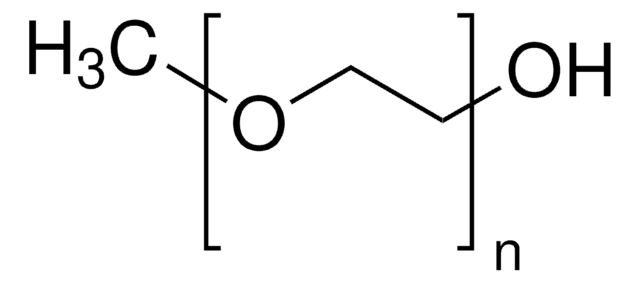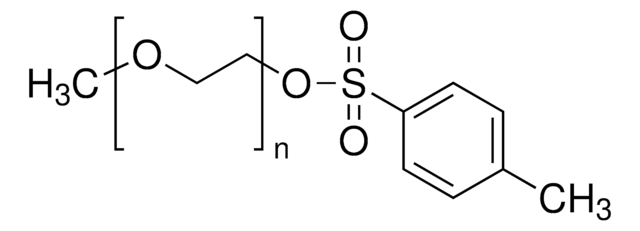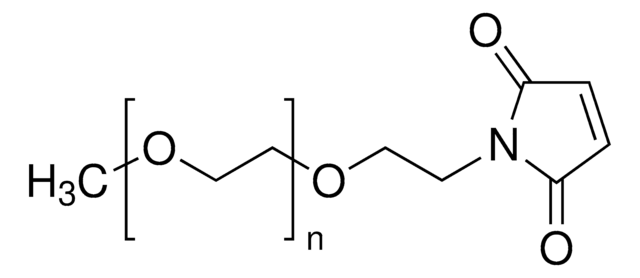202495
Poly(ethylene glycol) methyl ether
average MN 750, methoxy, hydroxyl
Synonyme(s) :
Polyethylene glycol monomethyl ether
About This Item
Produits recommandés
Nom du produit
Poly(ethylene glycol) methyl ether, average Mn 750
Densité de vapeur
>1 (vs air)
Niveau de qualité
Pression de vapeur
0.05 mmHg ( 20 °C)
Forme
paste
solid
Poids mol.
average Mn 750
Indice de réfraction
n20/D 1.459
Viscosité
10.5 cSt(210 °F)(lit.)
Température de transition
Tm 30 °C
Densité
1.094 g/mL at 25 °C
Extrémité Ω
hydroxyl
Extrémité α
methoxy
Chaîne SMILES
O(CCO)C
InChI
1S/C3H8O2/c1-5-3-2-4/h4H,2-3H2,1H3
Clé InChI
XNWFRZJHXBZDAG-UHFFFAOYSA-N
Vous recherchez des produits similaires ? Visite Guide de comparaison des produits
Catégories apparentées
Application
- As a chain transfer agent to synthesize amphiphilic block copolymers by metal-free ring-opening oligomerization.
- As a precursor to prepare retinoic acid-polyethylene glycol nanoassembly as an efficient drug delivery system.
- To prepare diblock copolymer with polylactic acid, which can be applied in the field of tissue engineering and drug delivery.
Code de la classe de stockage
10 - Combustible liquids
Classe de danger pour l'eau (WGK)
WGK 1
Point d'éclair (°F)
359.6 °F - closed cup
Point d'éclair (°C)
182 °C - closed cup
Équipement de protection individuelle
Eyeshields, Gloves
Faites votre choix parmi les versions les plus récentes :
Déjà en possession de ce produit ?
Retrouvez la documentation relative aux produits que vous avez récemment achetés dans la Bibliothèque de documents.
Les clients ont également consulté
Articles
Fouling Resistant Biomimetic Poly(Ethylene Glycol) Based Grafted Polymer Coatings
Progress in biotechnology fields such as tissue engineering and drug delivery is accompanied by an increasing demand for diverse functional biomaterials. One class of biomaterials that has been the subject of intense research interest is hydrogels, because they closely mimic the natural environment of cells, both chemically and physically and therefore can be used as support to grow cells. This article specifically discusses poly(ethylene glycol) (PEG) hydrogels, which are good for biological applications because they do not generally elicit an immune response. PEGs offer a readily available, easy to modify polymer for widespread use in hydrogel fabrication, including 2D and 3D scaffold for tissue culture. The degradable linkages also enable a variety of applications for release of therapeutic agents.
Devising biomaterial scaffolds that are capable of recapitulating critical aspects of the complex extracellular nature of living tissues in a threedimensional (3D) fashion is a challenging requirement in the field of tissue engineering and regenerative medicine.
Notre équipe de scientifiques dispose d'une expérience dans tous les secteurs de la recherche, notamment en sciences de la vie, science des matériaux, synthèse chimique, chromatographie, analyse et dans de nombreux autres domaines..
Contacter notre Service technique




